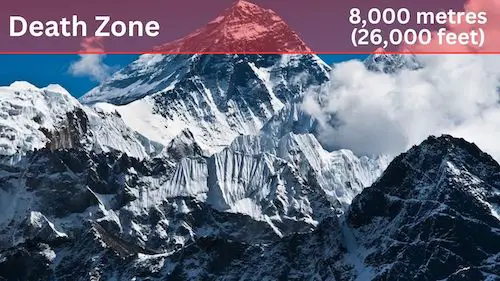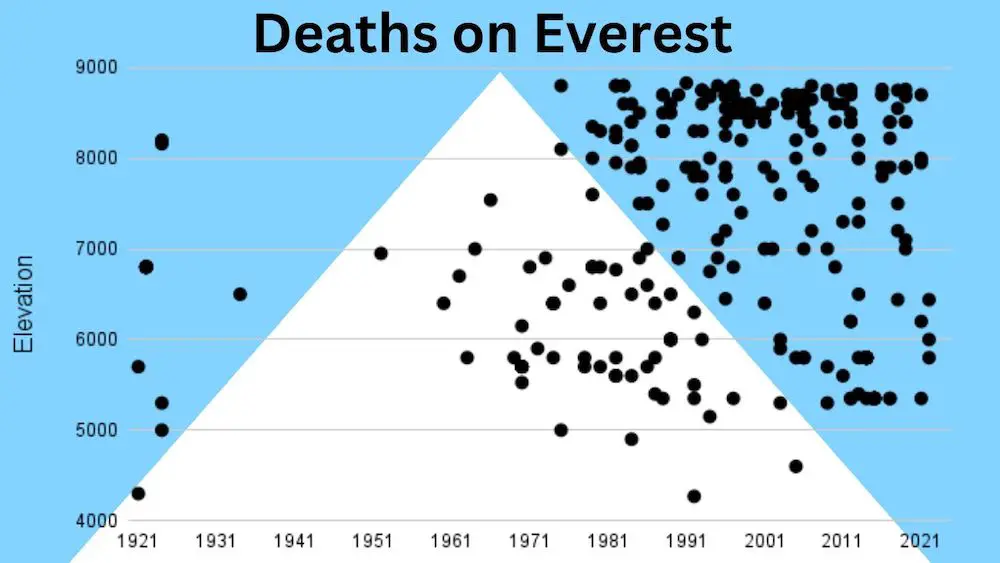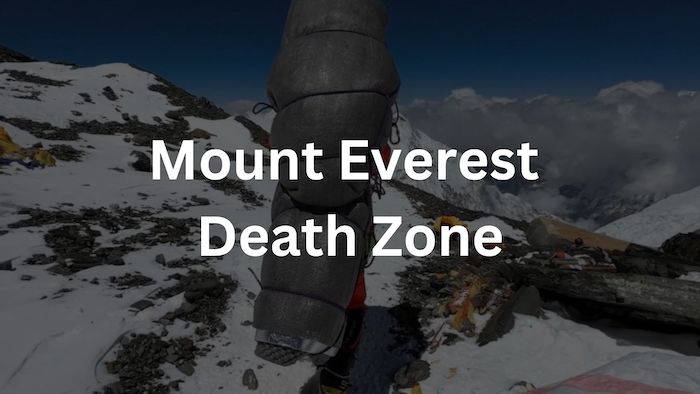Above a certain altitude, the human body faces significant challenges in maintaining proper functionality. Our optimal performance occurs at sea level, where our brains and lungs receive sufficient oxygen. However, climbers aiming to conquer Mount Everest, the world’s tallest peak at 29,029 feet (8,848 meters or 5.5 miles) above sea level, must confront a formidable obstacle known as “The Death Zone.”
The death zone begins at 8,000 meters, where oxygen levels plummet to such critical lows that the body experiences a gradual decline, minute by minute and cell by cell.
What is the Death Zone?

The term “death zone” refers to altitudes above a critical point where the available oxygen pressure is too low to sustain human life for an extended period. Typically, this point is identified as 8,000 meters (26,000 feet), where the atmospheric pressure drops to less than 356 millibars (10.5 inHg; 5.16 psi).
The concept of the death zone was first introduced by Edouard Wyss-Dunant, a Swiss doctor, in 1953, and he referred to it as the “lethal zone.” Notably, all 14 peaks exceeding 8,000 meters in altitude, including those in the Himalaya and Karakoram regions of Asia, are situated within this death zone.
The death zone has been responsible for numerous fatalities in high-altitude mountaineering. These deaths can occur directly due to the loss of vital bodily functions or indirectly due to poor decision-making under stressful conditions or physical debilitation leading to accidents. Ultimately, prolonged exposure above 8,000 meters (26,000 feet) without supplemental oxygen results in the deterioration of bodily functions and ultimately leads to death.
Why is it called The Death Zone of Mt Everest?
For climbers and scientists alike, the uppermost section of Everest, everything above 26,247 feet (8,000 meters), bears a haunting and apt name: “The Death Zone.” This extreme altitude zone is characterized by limited oxygen levels, leading to the gradual deterioration of the body’s cells. Climbers navigating this deadly zone may experience impaired judgment, as well as the risk of heart attacks, strokes, and severe altitude sickness, making it a treacherous endeavor.
Physiological Background of the Death Zone
Altitude poses unique challenges for the human body, and understanding its effects is crucial. From the body’s adaptive mechanisms of altitude acclimatization to the limits of human survival in the dreaded death zone, the sections below look at the complexities of high-altitude environments in regards to the human body.
1. The Human Body’s Endurance at Different Elevations
The human body’s optimal endurance is below 150 m (490 ft) elevation. At sea level, the concentration of oxygen (O2) in the air is approximately 20.9%, resulting in a partial pressure of O2 (PO2) of about 21.2 kPa (6.3 inHg; 3.07 psi), which is enough to saturate the oxygen-binding red pigment, hemoglobin, in red blood cells of healthy individuals.
As altitude increases, atmospheric pressure decreases while the O2 fraction remains constant. Consequently, the PO2 also decreases with altitude. For instance, at 5,500 m (18,000 ft) – the altitude of the Mount Everest base camp – the PO2 is about half of its sea level value, and at the summit of Mount Everest, it’s less than a third of sea level value.
2. The Body’s Response to Decreased Oxygen Pressure
To cope with reduced PO2 at higher altitudes, the body undergoes altitude acclimatization. The process involves several adaptive changes, including making additional red blood cells, increased heart rate, suppression of non-essential body functions, decreased food digestion efficiency, and increased breathing rate and depth. However, acclimatization typically requires days or even weeks to be effective. Failure to acclimatize can lead to altitude sickness, such as high-altitude pulmonary edema (HAPE) or cerebral edema (HACE).
3. Limits of Human Survival at High Altitudes
Humans have been known to survive for up to 2 years at an altitude of 5,950 m (19,520 ft), which corresponds to an atmospheric pressure of 475 millibars (14.0 inHg; 6.89 psi). However, this appears to be near the limit of the highest permanently tolerable altitude. At extreme altitudes above 7,500 m (24,600 ft), where the atmospheric pressure drops to 383 millibars (11.3 inHg; 5.55 psi), sleeping becomes very difficult, food digestion becomes nearly impossible, and the risk of HAPE or HACE increases significantly.
4. The Unsurvivable Death Zone for Human Acclimatization
Above the death zone, which is typically above 8,000 m (26,247 ft), no human body can acclimatize. The rate of oxygen consumption in the body surpasses the ability to replenish it, leading to a rapid deterioration of body functions, loss of consciousness, and ultimately, death. Some dispute the existence of a death zone, citing extreme tolerance to hypoxia in patients with chronic mountain sickness and normal fetuses in-utero, presenting similar pO2 levels to those at the summit of Mount Everest.
5. Using Oxygen to Mitigate Adverse Effects of Everest’s Death Zone
To reduce the harmful effects of extreme altitudes, mountaineers use supplemental oxygen in the death zone. The history of oxygen usage in mountaineering dates back to early expeditions. The first open-circuit oxygen apparatus was tested during the 1922 and 1924 British Mount Everest expeditions. In 1953, the first successful ascent of Mount Everest with supplemental oxygen was achieved by the second party of Edmund Hillary and Tenzing Norgay, who used supplemental oxygen.
How Dangerous Is Mount Everest’s Death Zone?
The death zone is one of the most dangerous parts of Everest. Climbers experience deprivation of oxygen, leading to critical impacts on their brains and lungs. The hazardous altitude elevates the risk of heart attacks and strokes, as well as impairs judgment due to the lack of oxygen. Which adversely impacts decision-making and critical thinking. Essentially, your body is breaking down and dying.
Below is a video by the Discovery channel that highlights just how dangerous Mount Everest’s death zone is.
Where Do Most Deaths Occur on Everest?
The majority of fatalities on Mount Everest occur during the descent from the summit, particularly in the “death zone” situated above 8,000 meters. Among the altitude-related illnesses that mountaineers face in the zone, high-altitude cerebral edema (HACE) is notably linked to a heightened risk of mortality.

The Image above shows the location of where the climbers have died on Everest, with the majority of them being in or around the death zone of Everest. With over 200 dead bodies on Everest, and with many of them in one area of the mountain, mountaineers have coined the area, the ‘Rainbow Valley of Everest’ because of the colorful down jackets that can be seen.
What Happens To Your Body in the Death Zone?
The death zone refers to altitudes above approximately 8,000 meters (26,247 feet), where the atmospheric pressure and oxygen levels are so low that the human body cannot acclimatize. As a result, the body faces severe physiological challenges, and its ability to function deteriorates rapidly. Here’s what happens to your body in the death zone:
1. Oxygen Deprivation (Hypoxia):
The death zone presents an extremely harsh environment for the human body due to severely reduced atmospheric pressure. As a consequence, the partial pressure of oxygen (PO2) is significantly lower, resulting in a lack of oxygen, a condition known as hypoxia. At these extreme altitudes, the thin air makes it nearly impossible for the respiratory system to extract sufficient oxygen to sustain normal bodily functions. This scarcity of oxygen affects cellular metabolism, including energy production, leading to a rapid decline in various physiological processes.
2. Cognitive and Physical Impairment:
As oxygen levels drop drastically, the brain’s functionality is severely affected. The lack of oxygen leads to impaired cognitive abilities, causing mental confusion, memory lapses, and difficulty making decisions. This cognitive impairment can impair a mountaineer’s ability to assess risks and make sound judgments, further complicating their situation in the hostile environment. Simultaneously, the body experiences muscular weakness due to inadequate oxygen supply to the muscles. In other words, simple tasks become physically exhausting, making even basic movements challenging and inefficient.
Additional physical impairments can include snow blindness and frostbite.
3. Cardiovascular Stress:
The heart, as a vital organ, faces immense stress in the death zone. To compensate for the reduced oxygen supply, the heart attempts to pump more blood to deliver the limited oxygen to essential body tissues. This increased workload puts significant strain on the cardiovascular system, elevating the risk of irregular heart rhythms and cardiac complications. Additionally, the blood’s ability to carry oxygen is compromised, further exacerbating the body’s oxygen deprivation.
4. Deterioration of Vital Organs:
Oxygen deprivation affects the proper functioning of vital organs. The liver and kidneys, responsible for detoxification and waste elimination, suffer impairments due to insufficient oxygen. The digestive system, non-essential for immediate survival, is suppressed as the body redirects resources to critical functions. This can lead to decreased food digestion efficiency and reduced nutrient absorption.
5. Increased Risk of Altitude Sickness and Irreversible Damage:
As climbers venture into the death zone, they face a heightened risk of severe altitude-related illnesses. High-altitude pulmonary edema (HAPE) and high-altitude cerebral edema (HACE) are potentially life-threatening conditions that can rapidly develop due to the body’s inability to adapt to the low-oxygen environment. These conditions may lead to fluid accumulation in the lungs or brain, causing respiratory distress or neurological symptoms including swelling in the brain.
Moreover, prolonged exposure to the death zone without supplemental oxygen or prompt descent can lead to irreversible damage to vital organs, ultimately resulting in loss of consciousness, coma, and death.
The Importance of Acclimatization:

Acclimatization to high altitudes is a natural process that most climbers can undergo. This adaptive mechanism involves short-term hyperventilation and long-term adjustments in response to the low oxygen levels. The body compensates by increasing oxygen uptake, transport, and utilization, facilitated by enhancements in red blood cell mass, myoglobin, and mitochondria.
However, not everyone can effectively acclimatize to high altitude, which may lead to the development of high-altitude diseases. These conditions include acute mountain sickness (AMS), high-altitude pulmonary edema (HAPE), high-altitude cerebral edema (HACE), and chronic mountain sickness (CMS). The susceptibility to these illnesses varies among individuals, making the incidence of high-altitude diseases unpredictable.
How to Acclimate to High-Altitude
Below are tips on how to acclimatize to high-altitude. By following these guidelines, you can increase your chances of a safe and more enjoyable experience.
1. Gradual Ascent:
Avoid rapid ascents to high elevations above 9,000 feet (2,750 meters) in a single day. If possible, spend a few days at an elevation of 8,000-9,000 feet before proceeding to higher altitudes. This allows your body to adapt gradually to the lower oxygen levels.
Once above 9,000 feet, limit your daily elevation gain to no more than 1,600 feet (488 meters). For every 3,300 feet (1,006 meters) you ascend, aim to spend an additional day at that elevation without further ascent.
2. Avoid Alcohol and Heavy Exercise:
Refrain from consuming alcohol and cigarettes and engaging in strenuous physical activities for at least the initial 48 hours after reaching an elevation above 8,000 feet. Alcohol, cigarettes and heavy exercise can exacerbate the effects of altitude and hinder acclimatization.
3. Pre-Trip Elevation Exposure:
If possible, consider traveling to elevations greater than 9,000 feet for at least two nights within 30 days before your high-altitude trip. This pre-exposure to higher elevations can help reduce the risk of altitude illness during your main expedition at a greater altitude.
4. Day Trips and Lower Elevation Sleep:
Opt for day trips to higher altitudes and then return to a lower elevation to sleep. This method, known as “climbing high and sleeping low,” can aid acclimatization and reduce the likelihood of altitude-related issues.
5. Medical Considerations:
Consult with your healthcare provider regarding the use of medications to prevent acute mountain sickness and expedite your adjustment to high elevations. Based on your medical history and trip plans, your doctor can recommend the most suitable medications for your needs.
Understanding the Altitude Zones on Everest:

Mount Everest, features several distinct altitude zones, each with its own unique characteristics and challenges for climbers. These zones are essential to understand for successful ascent planning and acclimatization. Here’s a description of the different altitude zones on Mount Everest:
1. Base Camp Zone (4,500 – 5,500 meters / 14,764 – 18,044 feet):
The Base Camp zone marks the starting point for most Everest expeditions. It serves as a logistical hub where climbers and support teams prepare for the ascent. At this elevation, the oxygen levels are significantly lower than at sea level, making it crucial for climbers to begin acclimatizing to the higher altitudes ahead.
2. Khumbu Icefall Zone (5,500 – 6,400 meters / 18,044 – 21,000 feet):
As climbers move beyond Base Camp, they encounter the dangerous Khumbu Icefall. This zone is characterized by massive seracs, crevasses, and unstable ice formations, making it one of the most dangerous parts of the ascent. Sherpas and guides carefully fix ropes and ladders to aid climbers in navigating this hazardous section.
3. Western Cwm Zone (6,400 – 7,900 meters / 21,000 – 25,918 feet):
The Western Cwm is a vast, flat valley filled with snow and ice, offering some respite from the technical challenges of the Khumbu Icefall. However, it is also known for its extreme heat during the day, reflecting sunlight off the surrounding walls. Climbers must hydrate adequately and protect themselves from sunburn at this stage.
4. Lhotse Face Zone (7,900 – 8,700 meters / 25,918 – 28,543 feet):
The Lhotse Face is a steep, icy slope that poses significant challenges to climbers. Ascending this section requires traversing fixed lines and negotiating the ice carefully. The zone’s high altitude and physical exertion increase the risk of exhaustion and altitude-related issues.
5. South Col (8,000 – 8,100 meters / 26,247 – 26,575 feet):
The South Col area of Everest, is the beginning of the Death Zone on Everest standing at around 8,000 meters. This zone earned its name due to its extreme altitude, where the human body struggles to acclimatize effectively. Oxygen levels are critically low, and climbers experience severe oxygen deprivation, leading to a rapid decline in physical and mental capabilities.
6. Summit Zone (8,848 meters / 29,029 feet):
The ultimate goal of every Everest expedition is the summit, standing at 8,848 meters (29,029 feet) above sea level. Reaching the summit is a monumental achievement, but climbers must contend with severe cold, hurricane-force winds, and the ongoing risk of altitude sickness. The time spent on the summit is brief due to the harsh conditions, and climbers must descend quickly to lower altitudes to ensure their safety.
The Death Zone: Everest’s Most Dangerous Region
The death zone on Mount Everest stands as a dangerous and unforgiving environment, where the human body faces extreme challenges due to the critically low oxygen levels. As climbers ascend into this perilous realm above 8,000 meters, their brains and lungs become starved of oxygen, leading to impaired judgment and heightened risks of heart attacks and strokes.
Despite these daunting circumstances, exceptional individuals like Babu Chiri Sherpa have defied the odds, demonstrating remarkable resilience and determination. Babu Chiri Sherpa achieved an astonishing feat by spending an incredible 21 hours on the summit of Everest, enduring the harsh conditions and pushing the limits of human endurance.
Nevertheless, it remains imperative for climbers to approach the death zone with utmost caution, employing meticulous planning, acclimatization strategies, and reliance on supplemental oxygen to maximize their safety and chances of success.
FAQs: Death Zone on Mount Everest
Below are the most frequently asked questions regarding the Mt. Everest death zone.
The death zone of Mount Everest is the high-altitude area above 26,247 ft (8,000 m) where oxygen levels are dangerously low, making it extremely challenging for climbers to survive for extended periods. At such heights, there is insufficient oxygen to sustain bodily functions, increasing the risk of severe health issues and fatality.
Climbers can only stay in the death zone for a limited time due to the dangerously low oxygen levels. Typically, climbers aim to spend between 16 and 20 hours in the region. To minimize the risk of severe health issues and fatality caused by the lack of oxygen and harsh conditions.
Everest has a death zone because its elevation surpasses 8,000m. Which marks the altitude that humans can no longer survive at due to the low oxygen levels. The death zone on Everest became famous due to its high fatality rate for climbers.
Most of the deaths on Everest take place in the death zone. An area situated above 8,000 meters (26,247 feet) in elevation. In this thin-air environment, oxygen levels plummet to dangerous lows, posing significant challenges for climbers to breathe and stay conscious.
